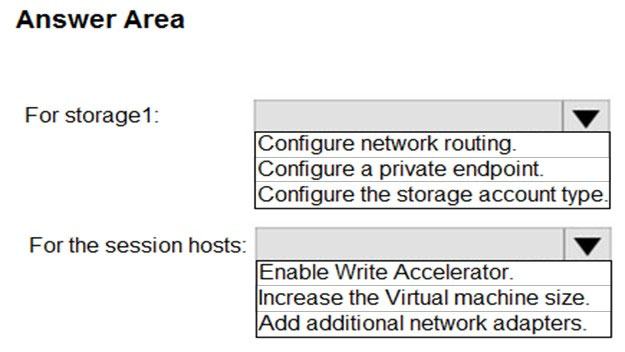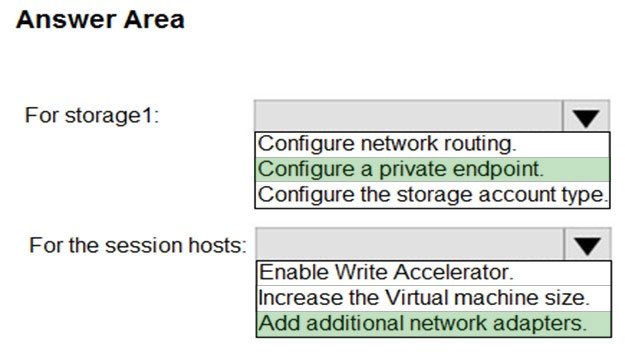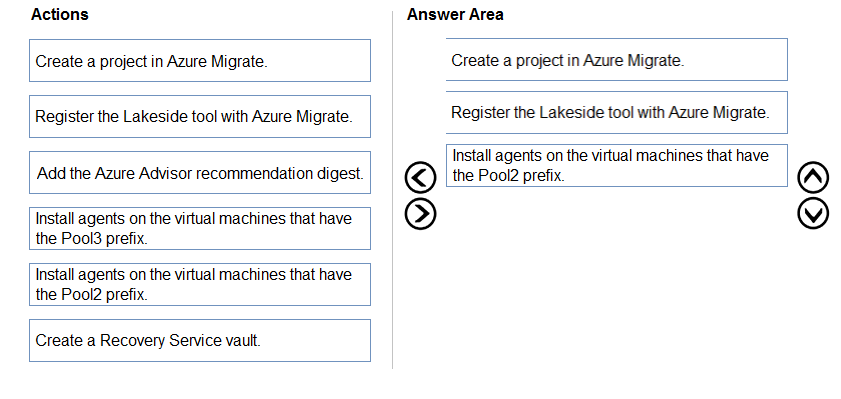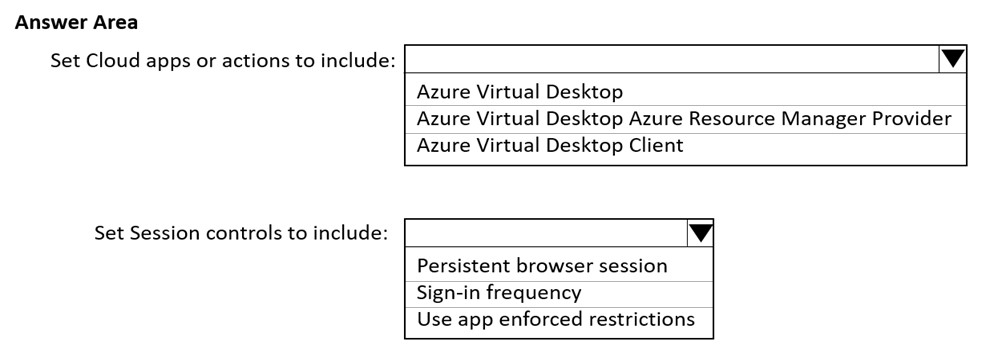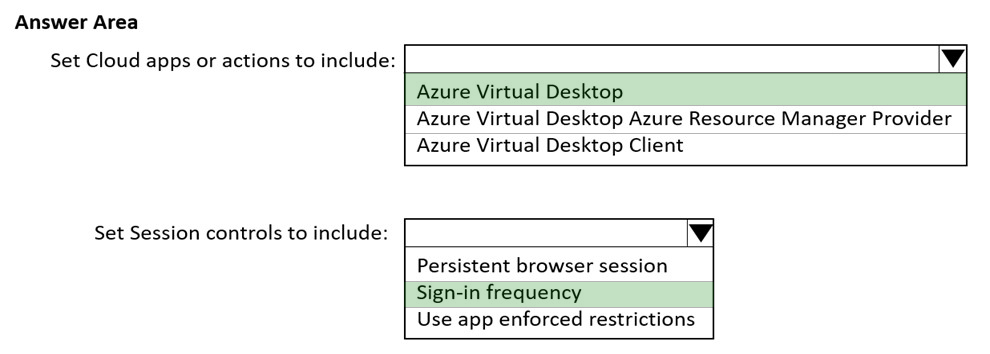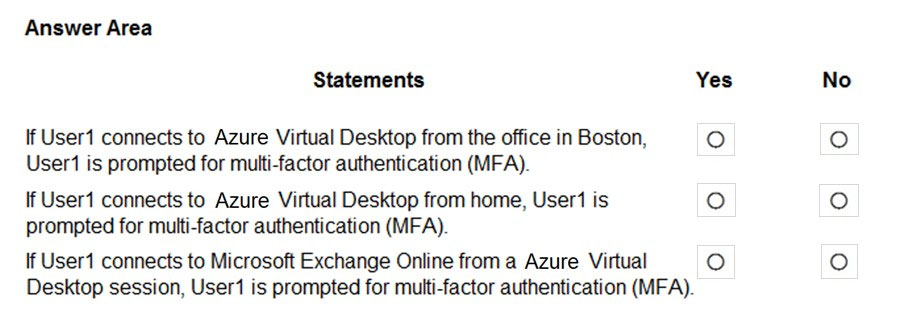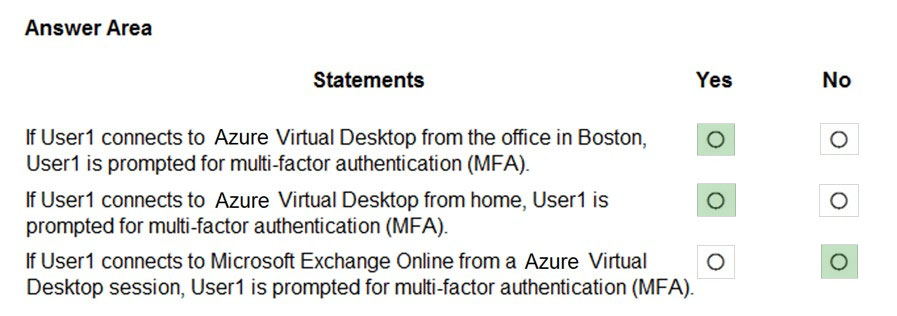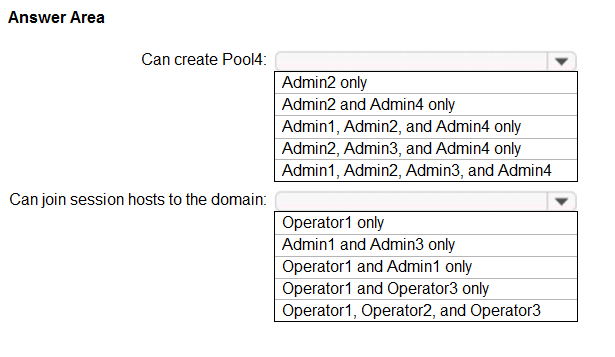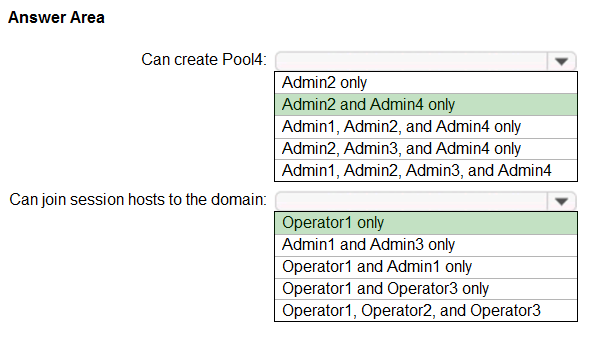AZ-140 Mock Test Free – 50 Realistic Questions to Prepare with Confidence.
Getting ready for your AZ-140 certification exam? Start your preparation the smart way with our AZ-140 Mock Test Free – a carefully crafted set of 50 realistic, exam-style questions to help you practice effectively and boost your confidence.
Using a mock test free for AZ-140 exam is one of the best ways to:
- Familiarize yourself with the actual exam format and question style
- Identify areas where you need more review
- Strengthen your time management and test-taking strategy
Below, you will find 50 free questions from our AZ-140 Mock Test Free resource. These questions are structured to reflect the real exam’s difficulty and content areas, helping you assess your readiness accurately.
HOTSPOT - You have an Azure Virtual Desktop host pool named Pool1 and an Azure Storage account named storage1. Pool1 and storage1 are in the same Azure region. The current network utilization of the session hosts during peak hours is 95%. You plan to use FSLogix profile containers stored in storage1 for users that connect to Pool1. You need to configure the session hosts and storage1 to minimize network latency when loading and updating profiles. What should you do? To answer, select the appropriate options in the answer area. NOTE: Each correct selection is worth one point. Hot Area:
You need to deploy the session hosts to meet the deployment requirements. Which PowerShell cmdlet should you run first?
A. Update-AzWvdSessionHost
B. Get-AzApiManagementSsoToken
C. Set-AzVMADDomainExtension
D. New-AzWvdRegistrationInfo
DRAG DROP - You need to evaluate the RDS deployment in the Seattle office. The solution must meet the technical requirements. Which three actions should you perform in sequence? To answer, move the appropriate actions from the list of actions to the answer area and arrange them in the correct order. Select and Place:
HOTSPOT - You have an Azure Virtual Desktop deployment that contains the session hosts shown in the following table.You have the users shows in the following table.
Users connect to Azure from the locations shown in the following table.
For each of the following statements, select Yes if the statement is true. Otherwise, select No. NOTE: Each correct selection is worth one point.
You need to recommend an authentication solution that meets the performance requirements. Which two actions should you include in the recommendation? Each correct answer presents part of the solution. NOTE: Each correct selection is worth one point.
A. Configure identity for all the session hosts.
B. In each Azure region that will contain the Azure Virtual Desktop session hosts, create an Azure Active Directory Domain Service (Azure AD DS) managed domain.
C. Deploy domain controllers for the on-premises Active Directory domain on Azure virtual machines to the new sites.
D. Deploy read-only domain controllers (RODCs) on Azure virtual machines to the new sites.
E. In each Azure region that will contain the Azure Virtual Desktop session hosts, create an Active Directory site.
You have an Azure Virtual Desktop deployment. You use the Start/Stop VMs during off-hours feature in Azure. You need to configure which virtual machines must never be stopped by the solution. What should you configure?
A. the Diagnostic settings of the host pool
B. the Start-Stop-VM task
C. an Azure Automation account variable
D. an action group
You have an Azure Virtual Desktop deployment. You need to recommend a solution to run containerized applications without installing the applications on the session hosts. What should you include in the recommendation?
A. EXE applications
B. MSI packages
C. APPX app packages
D. MSIX app packages
Your network contains an on-premises Active Directory domain that syncs to an Azure Active Directory (Azure AD) tenant. The domain contains the domain controllers shown in the following table.The DNS servers are configured to forward requests to an external DNS service. You create a new virtual network named VNET2 that is peered to VNET1 and has gateway transit enabled. You plan to implement an Azure Virtual Desktop host pool in VNET2. The session hosts will be joined to the Active Directory domain. You need to configure DNS to meet the following requirements: ✑ Ensure that Azure Virtual Desktop users can resolve on-premises servers and Azure resources. ✑ Ensure that azure Virtual Desktop remains operational if a DNS server fails. ✑ Minimize administrative effort. What should you configure?
A. the DNS settings of VNET2 to use Server2 and Server1
B. the DNS settings of VNET2 to use the Azure DNS service
C. the DNS settings of the virtual machines to use Server2 and Server1
D. the DNS settings of the virtual machines to use the Azure DNS service
HOTSPOT - You have an Azure subscription that contains the virtual machines shown in the following table.You create an Azure Compute Gallery as shown in the Azure compute gallery exhibit. (Click the Azure compute gallery tab.)
You create a virtual machine image definition as shown in the VM image definition exhibit. (Click the VM image definition tab.)
For each of the following statements, select Yes if the statement is true. Otherwise, select No. NOTE: Each correct selection is worth one point.
You are designing an Azure Virtual Desktop deployment. You identify the network latency between the locations where users reside and the planned deployment. What should you use to identify the best Azure region to deploy the host pool?
A. Azure Traffic Manager
B. Azure Virtual Desktop Experience Estimator
C. Azure Monitor for Azure Virtual Desktop
D. Azure Advisor
DRAG DROP - Your on-premises network contains an Active Directory domain named fabrikam.com that syncs with Azure Active Directory (Azure AD). The domain contains a global group named AVDusers. You have an Azure subscription that contains the resources shown in the following table.All Azure Virtual Desktop users are members of the AVDusers group. You plan to create FSLogix profile containers in Profiles1. You need to configure Profiles1 and fabrikam.com to ensure that the HostPool1 sessions hosts can access the FSLogix profile containers. What should you do? To answer, drag the appropriate configurations to the correct targets. Each configuration may be used once, more than once, or not at all. You may need to drag the split bar between panes or scroll to view content.
You have an Azure Virtual Desktop host pool that contains 20 Windows 10 Enterprise multi-session hosts. Users connect to the Azure Virtual Desktop deployment from computers that run Windows 10. You plan to implement FSLogix Application Masking. You need to deploy Application Masking rule sets. The solution must minimize administrative effort. To where should you copy the rule sets?
A. the FSLogix profile container of each user
B. C:Program FilesFSLogixAppsRules on every Windows 10 computer
C. C:Program FilesFSLogixAppsRules on every session host
You have an Azure Virtual Desktop deployment. You publish a RemoteApp named AppVersion1. You need AppVersion1 to appear in the Remote Desktop client as Sales Contact Application. Which PowerShell cmdlet should you use?
A. New-AzADApplication
B. Update-AzWvdApplicationGroup
C. Register-AzWvdApplicationGroup
D. Update-AzWvdApplication
HOTSPOT - You need to configure a conditional access policy to meet the authentication requirements. What should you include in the policy configuration? To answer, select the appropriate options in the answer area. NOTE: Each correct selection is worth one point. Hot Area:
HOTSPOT - Your company has the offices shown in the following table.The company has an Azure Active Directory (Azure AD) tenant named contoso.com that contains a user named User1. Users connect to a Azure Virtual Desktop deployment named WVD1. WVD1 contains session hosts that have public IP addresses from the 52.166.253.0/24 subnet. Contoso.com has a conditional access policy that has the following settings: ✑ Name: Policy1 ✑ Assignments: - Users and groups: User1 - Cloud apps or actions: Azure Virtual Desktop ✑ Access controls: - Grant: Grant access, Require multi-factor authentication ✑ Enable policy: On For each of the following statements, select Yes if the statement is true. Otherwise, select No. NOTE: Each correct selection is worth one point. Hot Area:
HOTSPOT - You have an Azure Virtual Desktop deployment that contains the resources shown in the following table.You create the resources shown in the following table.
You need to meet following requirements: • Back up the FSLogix profile containers used by HostPool1. • Backup the data disks in HostPool2. To which resources can you back up the profile containers and the data disks? To answer, select the appropriate options in the answer area. NOTE: Each correct selection is worth one point.
DRAG DROP - You have an Azure Virtual Desktop personal host pool. Each session host in the pool that has an operating system disk and a data disk. You need to back up the session host data disks. Which three actions should you perform in sequence? To answer, move the appropriate actions from the list of actions to the answer area and arrange them in the correct order.
You have an Azure subscription that contains 500 users. The users are assigned Microsoft Office 365 E1 licenses. You deploy an Azure Virtual Desktop solution that contains Windows 10 multi-session hosts and streams a custom remote app named App1. You need to ensure that the users are licensed to stream App1. The solution must minimize costs. Which license should you use?
A. Microsoft 365 E5
B. Office 365 E3
C. a Remote Desktop Services (RDS) client access license (CAL)
D. Windows 10 Enterprise E3
You have an Azure Virtual Desktop deployment that contains the host pools shown in the following table.You need to create a disaster recovery environment in the West US region. The solution must minimize costs and administrative effort. What should you do?
A. Regenerate the token and reregister the virtual machines in the host pools.
B. Create two new host pools in the West US region.
C. Run the Invoke-RdsUserSessionLogoff cmdlet.
D. Create an Azure Site Recovery plan.
You have an Azure Virtual Desktop host pool named Pool1 and an Azure Automation account named Account1. Pool1 is integrated with an Azure Active Directory Domain Services (Azure AD DS) managed domain named contoso.com. You plan to configure scaling for Pool1 by using Azure Automation runbooks. You need to authorize the runbooks to manage the scaling of Pool1. The solution must minimize administrative effort. What should you configure?
A. a managed identity in Azure Active Directory (Azure AD)
B. a group Managed Service Account (gMSA) in Azure AD DS
C. a Connections shared resource in Azure Automation
D. a Run As account in Azure Automation
DRAG DROP - You have an Azure Virtual Desktop deployment that contains the resources shown in the following table.You have a Windows 11 device named Device1 that has Azure Command-Line Interface (CLI) installed. You need to use Remote Desktop Connection (mstsc.exe) on Device1 to connect to Host1. Which three actions should you perform in sequence? To answer, move the appropriate actions from the list of actions to the answer area and arrange them in the correct order.
HOTSPOT - You have an Azure Virtual Desktop deployment that uses Cloud Cache to store user profiles. You plan to deploy Microsoft Defender Antivirus exclusions to the session hosts by using the following PowerShell script.Use the drop-down menus to select the answer choice that completes each statement based on the information presented in the graphic. NOTE: Each correct selection is worth one point.
You have an Azure Virtual Desktop host pool named Pool1. You are troubleshooting an issue for a Remote Desktop client that stopped responding. You need to restore the default Remote Desktop client settings and unsubscribe from all workspaces. Which command should you run?
A. msrdcw
B. resetengine
C. mstsc
D. resetpluginhost
You have an Azure Virtual Desktop deployment. In Azure Advisor, you discover the following recommendation related to Azure Virtual Desktop: ✑ Impact: Medium ✑ Description: No validation environment enabled ✑ Potential Benefit: Ensure business continuity through AVD service deployments ✑ Impacted Resource: 1 Host Pool What can you validate by implementing the recommendations?
A. Security settings of Azure Virtual Desktop
B. Capacity requirements of session hosts
C. Azure Site Recovery failover of the session hosts
D. Preview features for Azure Virtual Desktop
You have an Azure Virtual Desktop deployment that uses Microsoft 365 cloud services including Microsoft Teams. Users use the Remote Desktop client to connect to the deployment from computers that run Windows 10. You need to support audio and video in Azure Virtual Desktop and provide the users with access to Microsoft Teams calling and meeting features. Which three actions should you perform? Each correct answer presents part of the solution. NOTE: Each correct selection is worth one point.
A. Install the Microsoft Teams WebSocket Service on the Windows 10 computers
B. Configure the IsWVDEnvironment registry key on the Windows 10 computers
C. Configure the IsWVDEnvironment registry key on the virtual machines
D. Install the Microsoft Teams desktop app on the Windows 10 computers
E. Install the Microsoft Teams WebSocket Service on the virtual machines
F. Install the Microsoft Teams desktop app on the virtual machines
You need to recommend an authentication solution that meets the performance requirements. Which two actions should you include in the recommendation? Each correct answer presents part of the solution. NOTE: Each correct selection is worth one point.
A. Join all the session hosts to Azure AD.
B. In each Azure region that will contain the Azure Virtual Desktop session hosts, create an Azure Active Directory Domain Service (Azure AD DS) managed domain.
C. Deploy domain controllers for the on-premises Active Directory domain on Azure virtual machines to the new sites..
D. Deploy read-only domain controllers (RODCs) on Azure virtual machines to the new sites.
E. In each Azure region that will contain the Azure Virtual Desktop session hosts, create an Active Directory site.
You have an Azure Virtual Desktop deployment that contains a host pool. The host pool contains 10 session hosts. The session hosts are configured by using a custom image and ephemeral disks. You need to deploy Microsoft OneDrive for Business. Which two actions should you perform for each session host? Each correct answer presents part of the solution. NOTE: Each correct selection is worth one point.
A. Install FSLogix.
B. Install the OneDrive sync app by using the per-machine installation option.
C. Implement Application Masking.
D. Install the OneDrive sync app by using the per-user installation option.
E. Deploy an MSIX app attach package.
You have a shared image gallery that contains the Windows 10 images shown in the following table.You create an Azure Virtual Desktop deployment that has the following settings: Host pool name: Pool1 -
✑ Location: West US ✑ Host pool type: Personal Which images can you use for the session hosts?
A. Image1 only
B. Image1, Image2, Image3, and Image4
C. Image2 only
D. Image1 and Image2 only
E. Image1 and Image3 only
You have an Azure Virtual Desktop deployment. You need to create a host pool. The solution must ensure that during periods of low CPU usage, credits can be accumulated, and then used to raise performance above the purchased baseline during periods of high CPU usage. Which virtual machine series should you specify when you create the pool?
A. A-series
B. D-series
C. H-series
D. B-series
You have an Azure subscription named Subscription that contains an Azure Virtual Desktop host pool named HostPool1. HostPool1 is managed by using Microsoft Intune. Subscription1 contains 50 users that connect to HostPool1 by using computers that run Windows 10. You need to prevent the users from copying files between an Azure Virtual Desktop session and the computers. The solution must minimize administrative effort. What should you do?
A. Modify the RDP properties of HostPool1.
B. Create a Conditional Access policy in Azure Active Directory (Azure AD).
C. Create a compliance policy in Intune.
D. Create a configuration profile in Intune.
You have an Azure subscription that contains an Azure Compute Gallery named Gallery1 and a virtual machine named Template1. Template1 has custom apps and settings configured. You plan to deploy Azure Virtual Desktop session hosts by using a custom virtual machine image. The solution must meet the following requirements: • The custom image must be stored in Gallery1. • The custom image must be based on Template1. • All new session hosts must have unique computer names and identifiers. You need to create the custom image. What should you do in the Azure portal?
A. From Gallery1, create a new VM application definition.
B. From Gallery1, create a new VM image definition.
C. From Template1, capture a generalized virtual machine image.
D. From Template1, capture a specialized virtual machine image.
You have an Azure Virtual Desktop deployment that contains a host pool named Pool1. Pool1 contains two session hosts named Host1 and Host2. You need to enable screen capture protection for the deployment. What should you do?
A. Configure a Group Policy setting on Host1 and Host2.
B. From RDP Properties for Pool1, disable Clipboard redirection.
C. Install an Azure virtual machine extension on Host1 and Host2.
D. From RDP Properties for Pool1, disable encoding of redirected video.
After you answer a question in this section, you will NOT be able to return to it. As a result, these questions will not appear in the review screen. You have an Azure Virtual Desktop host pool named Pool1 that is integrated with an Azure Active Directory Domain Services (Azure AD DS) managed domain. You need to configure idle session timeout settings for users that connect to the session hosts in Pool1. Solution: From the Azure portal, you modify the Session behavior settings in the RDP Properties of Pool1. Does this meet the goal?
A. Yes
B. No
You plan to deploy Azure Virtual Desktop. The deployment will use existing virtual machines. You create a Azure Virtual Desktop host pool. You need to ensure that you can add the virtual machines to the host pool. What should you do first?
A. Register the Microsoft.DesktopVirtualization provider.
B. Generate a registration key.
C. Run the Invoke-AzVMRunCommand cmdlet.
D. Create a role assignment.
HOTSPOT - You have an Azure Virtual Desktop deployment that has just-in-time (JIT) VM access enabled. You need to request access to a session host by using JIT VM access. Which three virtual machine settings can you use to request access? To answer, select the appropriate settings in the answer area. NOTE: Each selection is worth one point.
HOTSPOT - You have an Azure Virtual Desktop deployment that contains two Azure AD-joined session hosts named Host1 and Host2. FSLogix Profile Containers and Office Containers have different locations and are used for both session hosts. You have an Azure AD tenant that contains the users shown in the following table.Host1 contains the local groups shown in the following table.
Host2 contains the local groups shown in the following table.
For each of the following statements, select Yes if the statement is true. Otherwise, select No. NOTE: Each correct selection is worth one point.
DRAG DROP - You have an Azure subscription that contains a virtual machine named VM1. VM1 runs a customized version of Windows 10 Enterprise. You generalize the operating system on VM1 and shut down the virtual machine. You need to deploy additional virtual machines based on an image of VM1 by using the Azure portal. Which three actions should you perform in sequence? To answer, move the appropriate actions from the list of actions to the answer area and arrange them in the correct order. Select and Place:
HOTSPOT - You have an Azure Virtual Desktop deployment that contains the resources shown in the following table.You need to perform the following configurations: • Enable a managed identity for App1. • Enable Clipboard redirection for App1. On which resources should you perform the configurations? To answer, select the appropriate options in the answer area. NOTE: Each correct selection is worth one point.
HOTSPOT - Which users can create Pool4, and which users can join session hosts to the domain? To answer, select the appropriate options in the answer area. NOTE: Each correct selection is worth one point. Hot Area:
Which two roles should you assign to Admin1 to meet the security requirements? Each correct answer presents part of the solution. NOTE: Each correct selection is worth one point.
A. Desktop Virtualization Host Pool Contributor
B. Desktop Virtualization Application Group Contributor
C. Desktop Virtualization Workspace Contributor
D. Desktop Virtualization Application Group Reader
E. User Access Administrator
You have a Azure Virtual Desktop host pool. You need to install Microsoft Antimalware for Azure on the session hosts. What should you do?
A. Add an extension to each session host.
B. From a Group Policy Object (GPO), enable Windows 10 security features.
C. Configure the RDP Properties of the host pool.
D. Sign in to each session host and install a Windows feature.
You have an Azure Active Directory Domain Services (Azure AD DS) domain named contoso.com. You have an Azure Storage account named storage1. Storage1 hosts a file share named share1 that has share and file system permissions configured. Share1 is configured to use contoso.com for authentication. You create an Azure Virtual Desktop host pool named Pool1. Pool1 contains two session hosts that use the Windows 10 multi-session + Microsoft 365 Apps image. You need to configure an FSLogix profile container for Pool1. What should you do next?
A. Install the FSLogix agent on the session hosts of Pool1.
B. From storage1, set Allow shared key access to Disabled.
C. Configure the Profiles setting for the session hosts of Pool1.
D. Generate a shared access signature (SAS) key for storage1.
You have an Azure Virtual Desktop deployment. The session hosts are joined to an on-premises Active Directory domain named contoso.com. You need to limit user sessions to three hours. What should you configure?
A. a Group Policy Object (GPO) in contoso.com.
B. the properties of the workspace
C. the RDP Properties of a host pool
D. just-in-time (JIT) VM access
You have an Azure AD tenant that contains a resource group named RG1. RG1 contains the resources shown in the following table.Your on-premises network has an IP address range of 192.168.10.0/24. Users on Host1 can successfully connect to the resources on the network. You add a new on-premises network that has an IP address range of 192.168.11.0/24 and contains a subnet. The subnet contains an application server named App1. Users report that Host1 cannot connect to App1. You need to ensure that the users on Host1 can access App1. What should you modify?
A. the Connections settings of VPNGW1
B. the Subnets setting of VNet1
C. the Configuration settings of LNGW1
D. the DNS server settings of VNet1
E. the RDP Properties of the host pool
You have an Azure storage account that contains the generalized Windows 10 disk images shown in the following table.You need to create an image that will be used to deploy an Azure Virtual Desktop session host. Which disk should you use?
A. Disk1
B. Disk2
C. Disk3
D. Disk4
You deploy multiple Azure Virtual Desktop session hosts that have only private IP addresses. You need to ensure that administrators can initiate an RDP session to the session hosts by using the Azure portal. What should you implement?
A. Remote Desktop Connection Broker (RD Connection Broker)
B. Azure Application Gateway
C. Azure Bastion
D. Remote Desktop Session Host (RD Session Host)
You have an Azure Virtual Desktop deployment that contains a session host named Host1. You need to configure Windows Defender Firewall to allow inbound network traffic for RDP Shortpath on Host1. Which program in the C:WindowsSystem32 folder should you specify in the inbound firewall rule?
A. Rdpshell.exe
B. Svchost.exe
C. Raserver.exe
D. Mstsc.exe
You have an Azure subscription that contains the resources shown in the following table.Which resources can you back up by using Azure Backup?
A. WVDVM-0 and share1 only
B. WVDVM-0 only
C. WVDVM-0, Image1, and Image2 only
D. WVDVM-0, share1, and Image1 only
E. WVDVM-0, share1, Image1, and Image2
HOTSPOT - You have an Azure subscription that contains the resources shown in the following table.You have a virtual machine named Server1 that runs Windows Server and is connected to VNet3. You need to deploy the Azure Virtual Desktop host pools shown in the following table.
The solution must meet the following requirements: • The session hosts in Pool1 must access Server1 via the Microsoft backbone network. • The session hosts in Pool2 must access storage1 via the Microsoft backbone network. What should you configure on the virtual networks? To answer, select the appropriate options in the answer area. NOTE: Each correct selection is worth one point.
After you answer a question in this section, you will NOT be able to return to it. As a result, these questions will not appear in the review screen. You have the following: ✑ A Microsoft 365 E5 tenant ✑ An on-premises Active Directory domain ✑ A hybrid Azure Active Directory (Azure AD) tenant ✑ An Azure Active Directory Domain Services (Azure AD DS) managed domain ✑ An Azure Virtual Desktop deployment The Azure Virtual Desktop deployment contains personal desktops that are hybrid joined to the on-premises domain and enrolled in Microsoft Intune. You need to configure the security settings for the Microsoft Edge browsers on the personal desktops. Solution: You configure a configuration profile in Intune. Does this meet the goal?
A. Yes
B. No
Access Full AZ-140 Mock Test Free
Want a full-length mock test experience? Click here to unlock the complete AZ-140 Mock Test Free set and get access to hundreds of additional practice questions covering all key topics.
We regularly update our question sets to stay aligned with the latest exam objectives—so check back often for fresh content!
Start practicing with our AZ-140 mock test free today—and take a major step toward exam success!


